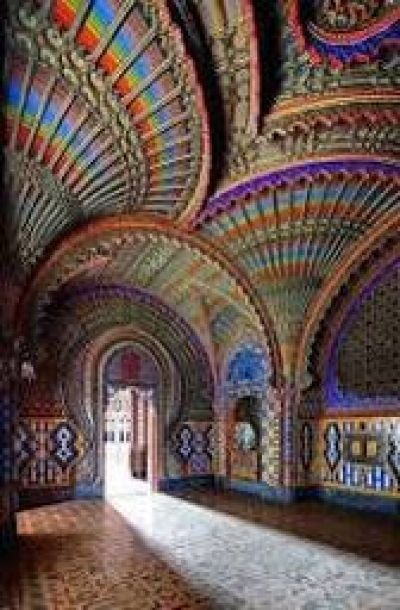Questo articolo descrive il Castello di Sammezzano, una struttura nel comune di Reggello (Toscana). Il castello ha una storia molto particolare. Fu costruito dagli antichi romani, ne fu ospite Carlo Magno. Nel corso di più di mille anni, il castello fu venduto più volte ed ebbe diversi proprietari, tra cui anche la famiglia Medici. Ad oggi è proprietaria un'agenzia a Dubai. Anche se il castello è crollato e ha mantenuto la sua forma originaria, è ancora vuoto ed ha bisogno di restauro.
In the province of Tuscany, the municipality of Reggello, the hamlet of Leccio, 19 miles from Florence, is the magnificent Castello di Sammezzano. The original structures and foundations date back to Roman times and it is said that in 780 AD, Charlemagne was a guest at the castle upon his return from Florence. During the Middle Ages, it served as a defensive fortress site. It was also home to Florentine aristocracy and in the post-WWII era, it was turned into a luxury hotel and restaurant. The castle has been used as a film location and has hosted special events. It is currently closed to the public.
The property belonged to quite a few noble families such as the Altoviti, the Ximenes, and the Medici. At the behest of Duke Cosimo, it passed to Giovanni Jacopo de Medici who in 1605 sold it to a Spanish nobleman, Sebastiano Ximenes of Aragon, and was in the family until the death of his last heir in1816 when it passed to the Panciatichi and ultimately to the Marquis Ferdinando Panciatichi Ximenes d’Aragon.
The Marquis was born in 1813 in Florence when Oriental culture was spreading through Europe. He was a Deputy of the Kingdom of Italy from 1853 until 1889 and hosted the King of Italy, Umberto I, in the castle. The Marquis was an architect, bibliophile, entrepreneur, politician, and botanist. In over 40 years in the mid-19th century, he enlarged and transformed the pre-existing building into a monument to Oriental art with three floors, a basement, ponds, water fountains, a bridge, and a terracotta garden. He trained the locals in different building techniques, ceramics, and art forms, and he also landscaped the 450 acres of parkland with exotic and indigenous trees such as oak, yucca, cedar, and the largest group of giant sequoia in Italy. The interior is decorated with arabesque elements inspired by the Alhambra in Granada Spain; Masonic and Indian symbology; brilliant, intricate patterns and colors fill the 365 unique rooms. The castle became a virtual journey through the East, China, Arabia, and Spain with ideas possibly gleaned from his many books.
The Marquis Ferdinando financed the Wars of Independence leading to the unification of Italy. Disenchanted with politics, he retreated into this world he created. So disappointed was he that in the Hall of Stalactites, where hundreds of stalactites hung from the vaulted ceiling, hidden between stuccoes of vibrant colors he wrote in Latin: “I am ashamed to say it, but it is true, Italy is in the hands of thieves, “harlots” and sensali, but not of this I regret, but of the fact that we deserve it.” Other phrases in Latin were inscribed throughout such as “Non Plus Ultra” to express his feeling that “there is nothing beyond this”.
On the main floor is a reception room, a small chapel, and the Hall of Peacocks with bundles of bright psychedelic rainbows of colors; the Atrium of the Columns leads to the Rotonda, an octagonal ballroom overlooked by 15 guest rooms in the Mudejar (Islamic) style; the Oath Room, Room of Love, Room of Mirrors, the White Room with mosaic tile floors, and the Hall of Lilies. The castle was filled with hidden niches, corners, windows, columns, arches, and vaults.
When the Marquis died on October 18, 1897, the castle was passed on to his daughter, Marianna, who married Paolucci di Sammezzano thus giving the castle the name Castello di Sammezzano. In 1927, after her death, a Certificate of Special Public Interest was issued to protect things of artistic value.
In the 1950s, then-owner, Oriani Pietro, partner of an Italian-British holding company, “Sammezzano Castle S.r.l.” made failed attempts to relaunch the destination as a luxury hotel. In the 1990s it was abandoned and bought and sold by the British and fell into further ruin.
On the bicentennial of the birth of the Marquis Ferdinando, 1813-2013, a committee, FPXA (Ferdinando Panciatichi Ximenes d’Aragon) was formed to restore and preserve the castle and historic parkland grounds which had long been in disrepair through neglect, theft, and vandalism and had become an endangered site closed to the public in 2016. In May 2021, an event was hosted on the grounds, “Save Sammezzano”. In 2016 and 2020, the castle was named “Il luoghi del cuore”, recognizing it as one of the seven most endangered sites in Italy.
In 2017, the castle was sold at auction for 15.4 million euros to Helitrope Limited, a Dubai-based company. I could not find any information as to what came of the sale but I surmise that the investment company did not come through with the money in time. I am hopeful that with the events planned to “Save Sammezzano”, the history and pictures of the castle on social media will attract the investor(s) necessary to reopen it to the public so that we may stand in awe of this technicolor marvel of art and architecture once again.
https://www.lagazzettaitaliana.com/history-culture/10158-save-sammezzano#sigProIde4714e5eb1




